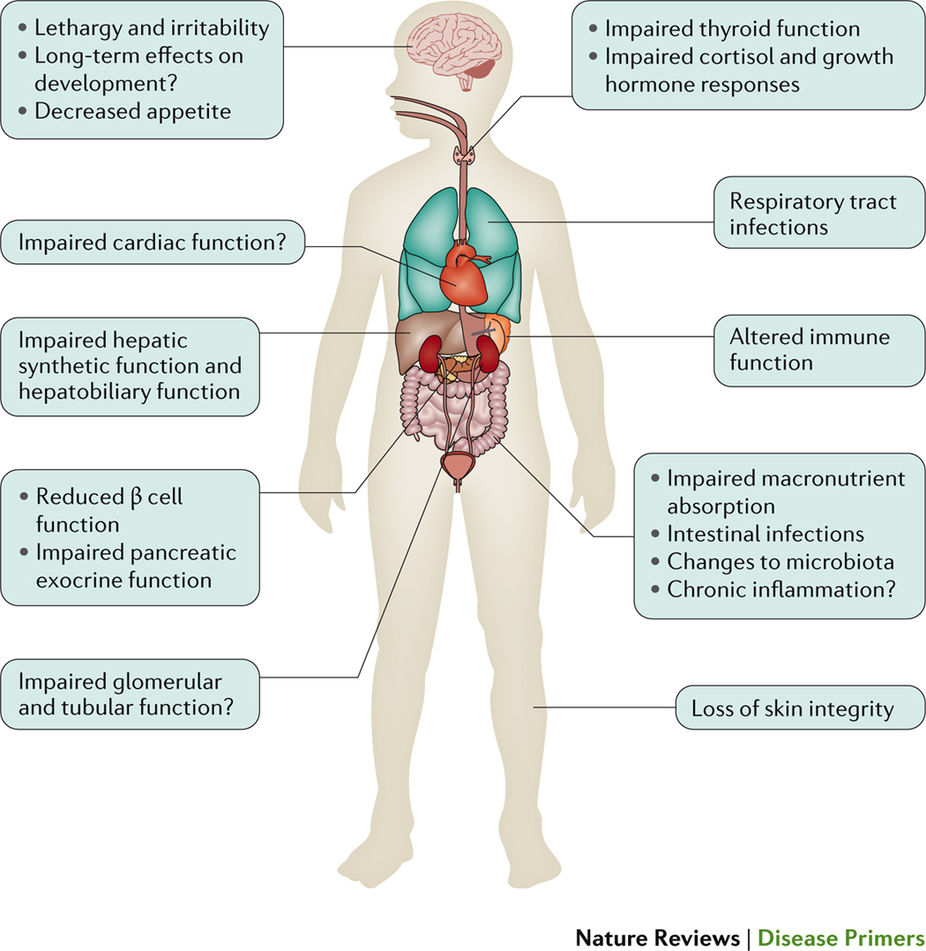乳幼児の重度栄養不良
Severe childhood malnutrition
2017年9月21日 Nature Reviews Disease Primers Article number: 17067 (2017) doi: 10.1038/nrdp.2017.67

低所得国や中所得国の5歳未満児は乳幼児栄養不良に陥ることが多く、主に、発育阻害、消耗、クワシオルコルなどの症状を表す。一般的に、重度の消耗やクワシオルコルは重度急性栄養不良と呼ばれている。しかし本稿では、これらの症状を「重度栄養不良」と記述することにした。というのも、これらの症状の背景には、慢性的な貧困をはじめ、衛生設備と衛生管理がほとんどの地域で欠如した貧しい生活環境、高頻度の感染症や環境障害、食料不足、妊婦と胎児の低栄養状態、乳幼児の不十分な栄養摂取などの影響が考えられるからである。重度栄養不良の小児は、重篤な疾患や死亡のリスクが高く、その主な原因は急性感染症といわれている。重度栄養不良の診断には国際的な成長基準が使用されるが、治療評価項目の指標にもなっている。現在、重度の消耗やクワシオルコルの早期検出に加えて、調理不要の栄養補助食品による外来療法がこれらの症状に対する治療の基礎になっており、入院治療が必要になるのは小児のほんの一部に過ぎない。しかし、栄養不良児の生理機能と代謝機能を正常な状態に戻すことは難しく、患児の再発および死亡のリスクは高いままである。重度栄養不良の病態生理、特にクワシオルコルの発症機構の理解を深め、予防と治療の新たな介入を開発するためには、さらなる研究が緊急に必要である。
PrimeView
乳幼児の重度栄養不良は、複数の社会的、経済的、政治的要因の結果として発生する。このPrimeViewではBhuttaらのPrimerの内容にそって、これらの要因を図説する。
本Primerの図解サマリー
The main forms of childhood malnutrition occur predominantly in children <5 years of age living in low-income and middle-income countries and include stunting, wasting and kwashiorkor, of which severe wasting and kwashiorkor are commonly referred to as severe acute malnutrition. Here, we use the term ‘severe malnutrition’ to describe these conditions to better reflect the contributions of chronic poverty, poor living conditions with pervasive deficits in sanitation and hygiene, a high prevalence of infectious diseases and environmental insults, food insecurity, poor maternal and fetal nutritional status and suboptimal nutritional intake in infancy and early childhood. Children with severe malnutrition have an increased risk of serious illness and death, primarily from acute infectious diseases. International growth standards are used for the diagnosis of severe malnutrition and provide therapeutic end points. The early detection of severe wasting and kwashiorkor and outpatient therapy for these conditions using ready-to-use therapeutic foods form the cornerstone of modern therapy, and only a small percentage of children require inpatient care. However, the normalization of physiological and metabolic functions in children with malnutrition is challenging, and children remain at high risk of relapse and death. Further research is urgently needed to improve our understanding of the pathophysiology of severe malnutrition, especially the mechanisms causing kwashiorkor, and to develop new interventions for prevention and treatment.

